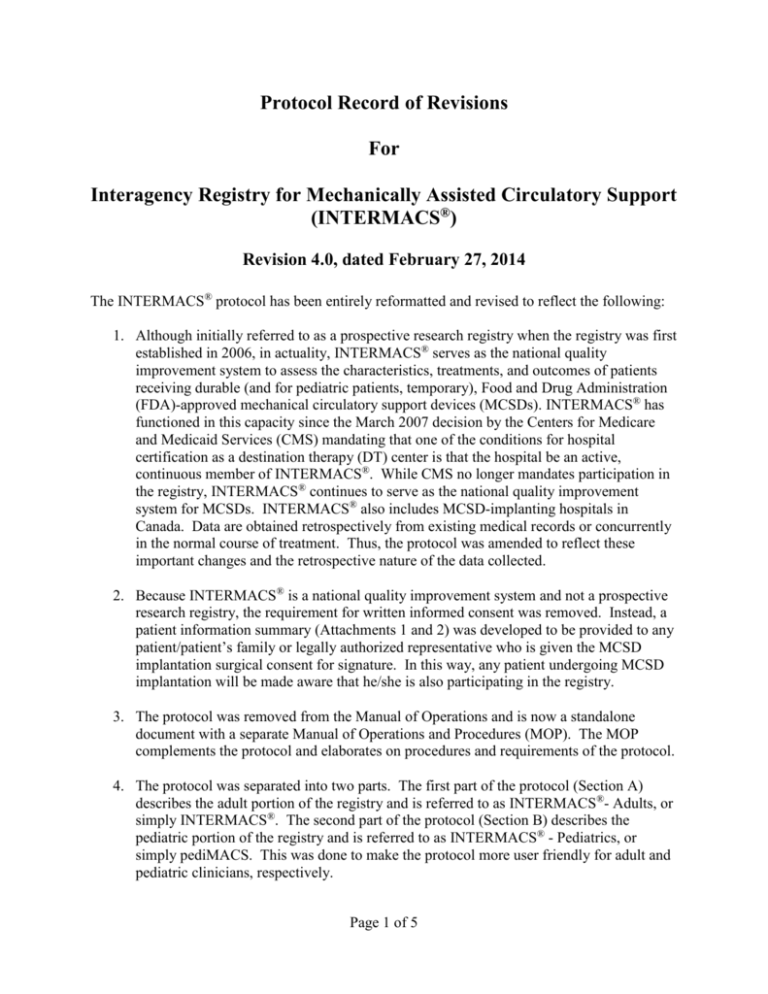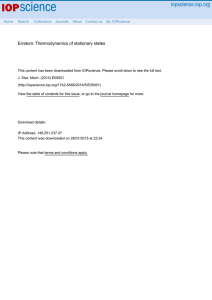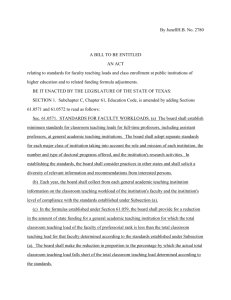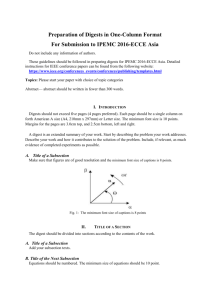Additions and Deletions
advertisement

Protocol Record of Revisions For Interagency Registry for Mechanically Assisted Circulatory Support (INTERMACS®) Revision 4.0, dated February 27, 2014 The INTERMACS® protocol has been entirely reformatted and revised to reflect the following: 1. Although initially referred to as a prospective research registry when the registry was first established in 2006, in actuality, INTERMACS® serves as the national quality improvement system to assess the characteristics, treatments, and outcomes of patients receiving durable (and for pediatric patients, temporary), Food and Drug Administration (FDA)-approved mechanical circulatory support devices (MCSDs). INTERMACS® has functioned in this capacity since the March 2007 decision by the Centers for Medicare and Medicaid Services (CMS) mandating that one of the conditions for hospital certification as a destination therapy (DT) center is that the hospital be an active, continuous member of INTERMACS®. While CMS no longer mandates participation in the registry, INTERMACS® continues to serve as the national quality improvement system for MCSDs. INTERMACS® also includes MCSD-implanting hospitals in Canada. Data are obtained retrospectively from existing medical records or concurrently in the normal course of treatment. Thus, the protocol was amended to reflect these important changes and the retrospective nature of the data collected. 2. Because INTERMACS® is a national quality improvement system and not a prospective research registry, the requirement for written informed consent was removed. Instead, a patient information summary (Attachments 1 and 2) was developed to be provided to any patient/patient’s family or legally authorized representative who is given the MCSD implantation surgical consent for signature. In this way, any patient undergoing MCSD implantation will be made aware that he/she is also participating in the registry. 3. The protocol was removed from the Manual of Operations and is now a standalone document with a separate Manual of Operations and Procedures (MOP). The MOP complements the protocol and elaborates on procedures and requirements of the protocol. 4. The protocol was separated into two parts. The first part of the protocol (Section A) describes the adult portion of the registry and is referred to as INTERMACS®- Adults, or simply INTERMACS®. The second part of the protocol (Section B) describes the pediatric portion of the registry and is referred to as INTERMACS® - Pediatrics, or simply pediMACS. This was done to make the protocol more user friendly for adult and pediatric clinicians, respectively. Page 1 of 5 General revisions were made throughout the protocol as follows: 1. All references to a “prospective” registry or design were removed because INTERMACS® data is obtained retrospectively from existing medical records or concurrently in the normal course of treatment. 2. All references to specific Appendices, which are part of the MOP, have been replaced with a reference to the MOP. Additionally, for more detailed procedures and requirements, the MOP was referenced in various subsections of the protocol. 3. Typographical and grammatical errors were corrected. 4. Modifications were made to the text for consistency between sections, as well as to update sections to accurately reflect any changes in practice. 5. All abbreviations were defined in an Abbreviations Section, and were defined when used for the first time in the text. 6. Section titles throughout the protocol were modified for clarity and consistency. 7. The table of contents and page numbering were updated to reflect protocol modifications. Specific revisions made to the protocol include: 1. Updating the title page to remove the wording “Manual of Operations” and to include the study title, the Principal Investigator, the name of the Data Coordinating center, and the NHLBI contract number. 2. Adding a “List of Abbreviations” immediately following the Table of Contents for convenience of clinicians. 3. Combining the “Executive Summary” (formerly Section 1.0) with “Background” information to more accurately explain the registry and its purpose. 4. Removing text related to the purpose of the registry from the “Study Description and Purpose” section (formerly Section 2.0, now referred to as “Registry Description”) to focus on the registry description only; the purpose of the registry is now stated in the “Executive Summary and Background” section. 5. Adding a “Registry Organization” section immediately following “Registry Description” to describe how this multi-center registry is managed. 6. Separating the INTERMACS®- Adults (INTERMACS®) part of the protocol from the INTERMACS®- Pediatrics (pediMACS) part for convenience, consistency, and clarity for adult and pediatric clinicians involved in the registry, respectively. INTERMACS®Adults is presented first and relabeled as Sections A.1.0 through A.8.0, while pediMACS Page 2 of 5 is presented second and labeled as Sections B.1.0 through B.8.0. Where possible sections (and subsections) between INTERMACS® and pediMACS are labeled identically. 7. Adding Attachments to the end of the protocol: a. Attachment 1: Patient Information for Adults b. Attachment 2: Patient Information for Children. 8. Within the corresponding INTERMACS and pediMACS sections: a. Removing the “Observational Study Monitoring Board” subsection (formerly Subsection 3.5) under “Registry Design” (formerly Section 3.0, now Section A.1.0 / B.1.0) because it is now described in detail in the MOP. b. Simplifying the “Patient Eligibility” subsection (formerly Subsection 3.1, now Subsection A.1.1 / B.1.1) for clarity. c. Under “Site Eligibility and Enrollment” (formerly Section 4.0, now Section A.2.0 / B.2.0): 1) All references to informed consent(s) were removed from the “IRB Approval” subsection (formerly Subsection 4.3, now Subsection A.2.3 /B.2.3), and this Subsection has been retitled “IRB/EB Approval” as described below under item e.2. 2) The “Participation Agreement” and “Participation Fee” subsections (formerly Subsections 4.4 and 4.7, respectively) were combined into one “Agreements and Fees” section for clarity (Subsection A.2.4/B.2.4). Additionally, this section was updated to include the Business Associate Agreement, a new requirement for site participation. 3) The “Human Subjects Training” subsection (formerly Subsection 4.6) was replaced with “Privacy Awareness Training” (now Subsections A.2.6 / B.2.6. This modification was made to reflect the training required for a quality improvement registry. 4) The “Training” subsection (formerly Subsection 4.8, now Subsection A.2.7 / B.2.7) has been retitled “Registry-specific Training” and updated to reflect current practices more accurately. d. Under “Patient Safety” (formerly Section 5.0, now Section A.3.0 / B.3.0): 1) The “Risks and Benefits” subsection (formerly Subsection 5.1, now Subsection A.3.1 / B.3.1) was revised to state that there is no added procedural risk to patients through involvement in INTERMACS®/pediMACS as no risk or procedures beyond those required for routine care will be imposed. This section now includes information on the safeguards and policies in place to keep protected health information (PHI) confidential. The subsection on benefits was revised to clearly state that there is no direct benefit to registry participants. 2) Information in the “IRB Review and Approval” subsection (formerly Subsection 5.2) was moved up to and combined with the “IRB Approval” subsection and retitled “IRB/EB Approval” to accommodate participation of Canadian sites (now Subsection A.2.3 / B.2.3) under “Site Eligibility and Enrollment”. 3) The “Informed Consent Process” subsection (formerly Subsection 5.3, now Subsection A.3.2 / B.3.2) was rewritten to remove the requirement for written Page 3 of 5 e. f. g. h. informed consent and clearly state that no data beyond the data gathered in the course of routine care will be collected. 4) A “Registry Interventions” subsection (Subsection A.3.3 / B.3.3) was added to state that no additional interventions outside of the normal course of care will be performed. 5) A “Patient Recruitment, Costs, and Compensation” subsection (Subsection A.3.4 / B.3.4) was added to state that recruitment is not applicable since the registry obtains information through a review of existing medical records and that there are no costs or compensation to the patient or the patient’s family for participation in the registry. 6) Because neurocognitive data collection is not part of pediMACS, no references to neurocognitive testing are included in Section B.3.0. Under “Data Collection” (formerly Section 6.0, now Section A.4.0 / B.4.0): 1) A new section entitled “Assignment of Registry Identification Number” was added as Subsection A.4.1 / B.4.1to clearly state that the registry assigns an identification number, which will be used as the primary patient identifier between the site, the registry, manufacturers, and government agencies. 2) The subsection entitled “Web-based Data Entry and Systems Security” (formerly Subsection 6.1, now Subsection A.4.2 / B.4.2) was modified to state the types of PHI submitted to the registry and the purpose for collecting limited PHI, as well as security measures in place to protect the limited PHI collected. 3) The subsection entitled “Clinical Data” (formerly Subsection 6.2, now Subsection A.4.3 / B.4.3) was updated to reflect current clinical data collected. 4) The subsection entitled “Neurocognitive Data” (formerly Subsection 6.4, now Subsection A.4.3) was updated to include the Modified Rankin Scale (MRS) score collected for adults who experience a neurological event after implant. Of note, because neurocognitive data collection is not part of pediMACS, Subsection 4.5 is not included in Section B.4.0 (unlike Section A.4.0). 5) A new subsection entitled “Functional Capacity Data” was added as Subsection A.4.6 / B.4.6 to explain the functional capacity measures collected pre- and postimplant. Under “Analyses of Registry Data (formerly Section 7.0 and now Section A.5.0 / B.5.0), the Subsection “Transfer of Data to UAB for Analyses (formerly Subsection 7.5) was deleted because the database is now physically located at UAB and does not require transfer of data to UAB from a subcontractor. The Subsection “Analytic Methods” was renumbered accordingly (now Subsection A.5.5 /B.5.5). The Section entitled “Periodic Statistical Summaries” (formerly Section 8.0) has been renamed “Reports” (now Section A.6.0 / B.6.0), and each subsection has been revised to reflect changes in reporting requirements, as well as to clarify medical device reporting requirements to the FDA and MCSD manufacturers. Additionally, a Table summarizing reporting requirements under 21 CRF 803 was added to Subsections A.6.3 and B.6.3. The section entitled, “Quality Assurance” (formerly Section 9.0, now Section A.7.0 / B.7.0), which includes three subsections, was revised to reflect current practice. Page 4 of 5 i. The subsections under “Centers: Requirements, Training, Assistance and Audits” (formerly Section 10.0 and now Section A.8.0 / B.8.0) were updated to more accurately reflect current practice. Page 5 of 5




